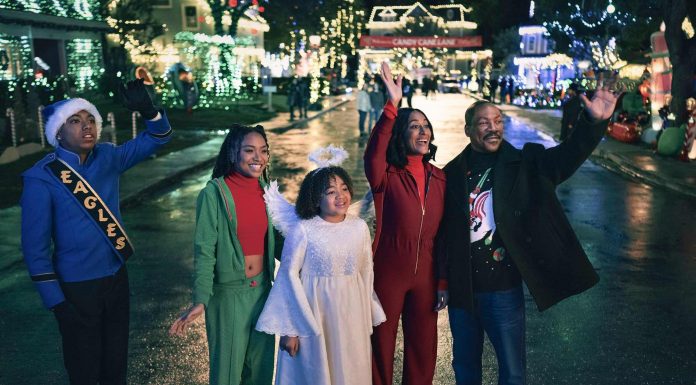This charming Christmas comedy, “Candy Cane Lane,” takes you beyond the typical cold settings found in holiday movies. Welcome to its magical universe. Directed by Reginald Hudlin this film masterpiece takes us inside the colorful world of Southern California’s actual Candy Cane Lane, a phenomenon that has been bringing happiness for more than 70 years.
Eddie Murphy plays Chris Carver, a resolute parent involved in a fierce rivalry to win his neighborhood’s annual Christmas home decoration contest, in this charming story. Is Chris Carver’s character based on a real-life person? As we delve into the enchantment of “Candy Cane Lane,” let’s examine the intriguing fusion of fact and fiction that creates this endearing holiday movie.
Is the movie Candy Cane Lane based on a true story?
“Candy Cane Lane” takes its enchantment from real phenomena in Christmas decoration that began almost seven decades ago, so it’s not just a work of fiction. Kelly Younger, the screenwriter, reveals a personal connection to the narrative by stating that his father was an artist and accomplished woodworker who was instrumental in the real Candy Cane Lane in El Segundo, California.
Younger vividly recalls his early years as he talks about his father’s active involvement in the holiday frenzy, which turned their house into a stunning display that became well-known throughout the neighborhood. This reality is reflected in the movie, where Younger’s father’s enthusiasm and inventiveness are mirrored by Eddie Murphy’s character, Chris Carver, as he attempts to win the neighborhood decorating competition.
This touching story takes place against the backdrop of El Segundo’s real Candy Cane Lane, where families go above and beyond to spread holiday cheer with magnificent decorations. Even though the plot is fanciful, it is based on real-life experiences of families making enchanted Christmas decorations that spread happiness and a sense of community.
Chris Carver’s character was inspired by Kelly Younger’s Father
The personal connection Kelly Younger has to the story gives “Candy Cane Lane” a level of realism. Chris Carver, the main character of the movie, connects strongly with his father’s portrayal as a woodworker and artist who overdecorated their home. Younger talks about his early years and how much it delighted him to see his house turned into a winter wonderland as he reflects on his father’s artistic pursuits.
Younger created an original story that transcends the conventional snowy Christmas scene, using inspiration from the historical Candy Cane Lane tradition that dates back to the late 1940s. “Candy Cane Lane” revolves around Younger’s father’s love of making handcrafted decorations and the warmth and romance of the holidays.
Younger explains in a behind-the-scenes film how the real Candy Cane Lane in El Segundo has both a grand opening night ceremony and intricate decorations. This event adds to the feeling of togetherness and mutual happiness that characterizes the holiday season, complete with a live band, fire engines, and Santa Claus himself.
As Chris Carver, Eddie Murphy, a well-known comedian, brings the joy of the holidays to life. Murphy’s love of being a father and a family guy is reflected in the writing, which gives his portrayal a sincere connection to the narrative. Younger praises Murphy for using his distinct style to bring the characters to life and making the script into the next big holiday classic.
The director of “Candy Cane Lane,” Reginald Hudlin, highlights the exceptional chance to capture the Southern California Christmas charm. He emphasizes the sincere happiness and amazement that families feel over the holidays, adding that the movie attempts to capture the essence of Christmas as it is observed in actual communities.
After working together on the beloved 1992 romantic comedy Boomerang, Younger, Hudlin, and Murphy reconnect for “Candy Cane Lane” after a few decades. Their approach clearly reflects the passing of time, as the film depicts their transition from singledom to marriage and parenting.
The filmmakers say they want to make a holiday film that blends the beauty of Christmas with the stresses of the real world during this stressful time of year. Younger emphasizes how crucial it is to show a real family overcoming life’s obstacles in a real neighborhood while adding a dash of magic. The core of the movie is this harmony between the commonplace and the spectacular, driven by the spirit of Christmas.
Finally, “Candy Cane Lane” surpasses the limitations of a conventional Christmas film by taking cues from an actual custom that perfectly captures the essence of the season. Younger’s personal bond, Hudlin’s artistic vision, and Murphy’s charisma combine to create a picture that perfectly embodies the Southern California Christmas joy. “Candy Cane Lane” transports viewers to a realm where the love of family and home is paramount as the protagonists deal with the seasonal obstacles while incorporating a hint of magic.







